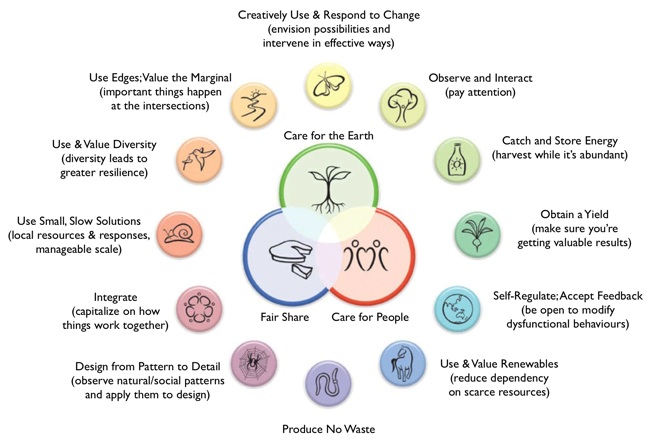What is permaculture?
Permaculture is a design process derived from natural systems and cycles in which we live and are a part of. Made up of a set of 3 core principles, permaculture designs can be applied to all aspects of human development in order to build healthy communities for ourselves and future generations. The name ‘Permaculture’ is short for ‘Permanent Culture’.
Permaculture also has three core ethics summarized as earth care, people care and fair share.
- Care for the earth: is the provision for all life systems to continue and multiply. This is the first principle, because without a healthy earth, humans cannot flourish.
- Care for the People: is the provision for people to access those resources necessary for their existence.
- Share the Surplus: is reinvesting surpluses back into the system to provide for the first two ethics. This includes a re-definition of waste as a resource to share into the system to re-purpose into usefulness.
Permaculture design is a model which aims to create stable, productive systems that provide for human needs, harmoniously integrating the land with its inhabitants. The ecological processes of plants, animals, their nutrient cycles, climatic factors and weather cycles are all part of the picture. Inhabitants’ needs are provided for using proven technologies for food, energy, shelter and infrastructure, but lowering, or eliminating significantly, environmental impact. Elements in a system are viewed in relationship to other elements, where the outputs of one element become the inputs of another.Within a Permaculture designed system, work is also redefined and reduced, as the needs of the system are met by the system in an integrated fashion.
Pollution is also minimized as materials are carefully selected so that “wastes” can become resources, productivity and yields increase, and environments are restored. Permaculture design principles can be applied to any environment, at any scale from dense urban settlements to individual homes, from farms to the built environment even to organizations and entire regions. The intent is that, by training individuals in a core set of design principles, those individuals can apply permaculture designs to their own environments and build increasingly sustainable human settlements.
Such a model helps us adapt to current challenges in making human sustainable and resilience and reduce human society’s increasing reliance on systems of production and distribution that Permaculture’s founder Bill Mollison and many others have identified as fundamentally at odds with sustaining health for humans and for Earth’s ecosystems.
History and Practice:
Early recorded contemporary practices of permaculture as systematic methods were practiced in the late 1940’s by Massanobu Fukuoka and by Austrian farmer Sepp Holzer in the 1960s, but Permaculture as a design method was scientifically developed by Australians Bill Mollison and David Holmgren and their associates during the 1970s in a series of publications. The word permaculture was originally described by Mollison as a combination of the words permanent agriculture, but it has expanding beyond agriculture to other human systems and settlements and so the words permanent culture are now used. The idea of food forests was developed in the UK by Robert Hart and more recently by Martin Crawford.
Also in the UK Patrick Whitefield has developed permaculture food system concepts for a temperate climate. Permaculture has developed a large international following and network of projects which have applied its principals. This “permaculture community” continues to expand application of the original principles, integrating a range of ideas of sustainable alternative culture, in diverse areas, such as, natural building, education methodology, energy systems, organization structures and these examples are shared through trainers in a community of practice network, publications, gardens, intentional communities, courses, and internet forums. Most recently Permaculture inspired the beginning of the grass routes Transition movement and continues to inform its development.

